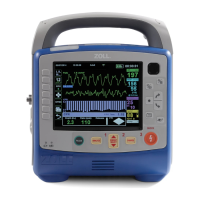Chapter 1 General Information
1-18 www.zoll.com 9650-001355-01 Rev. M
Defibrillation
• The ZOLL X Series can deliver 200 joules of electrical energy. If this electrical energy is not
discharged properly, as described in the this manual, the electrical energy could cause
personal injury or death to the operator or bystander.
• To avoid possible damage to the X Series unit, turn off pacing before defibrillating the
patient with a second defibrillator.
• After a synchronized cardioversion, the SYNC mode may be cleared after each shock or
disarm. The user may have to reselect (press) the SYNC button after each synchronized
cardioversion shock performed on a patient. In Defib/Pacer Default settings in the
Supervisor Setup menu, the X Series can be configured to remain in the SYNC mode after
each synchronized cardioversion.
• Synchronized cardioversion can be performed in the paddle monitoring mode. However, it
is possible that artifact can be produced by the moving paddles, which could cause the
defibrillator to trigger on the artifact. It is recommended that monitoring in leads I, II or III
be used during synchronized cardioversion. Paddle monitoring should not be used for
elective cardioversions procedures.
• To avoid stress to the defibrillator or the tester, never attempt to repeatedly charge and
discharge the defibrillator in rapid succession. If a need for repetitive testing arises, allow a
waiting period of at least 2 minutes after every third discharge.
• In the SYNC mode, the defibrillator does not discharge without a command signal (R-wave
detection) from the ECG monitor indicated by a SYNC marker on the trace and a flashing
SYNC indicator.
• If conductive gel forms a continuous path between the defibrillator electrodes, delivered
energy may be dramatically reduced to zero. In this case, reposition the electrodes to
eliminate the shunting path before attempting additional shocks.
• Improper defibrillation technique can cause skin burns. To limit possible skin burns, use
only ZOLL defibrillation gel on paddles, ensure the gel covers the entire paddle surface and
press firmly against patient’s chest.
• If a new energy level is selected after the CHARGE button is pushed and while the
defibrillator is charging or charged, the defibrillator will disarm. The CHARGE button will
need to be pressed again to charge to the new energy level.
• Prior to defibrillation, disconnect from the patient any medical electronic device that is not
labeled “defibrillation protected.”
• Before charging the defibrillator, verify that the energy selected on the display is the desired
output.
• Defibrillation takes priority over external pacing. Should the defibrillator be charged during
the administration of external pacing, the pacer turns off and the defibrillator charges to the
selected energy.
• If the X Series unit is in a shock-ready state, and you have to change the patient mode, wait
until the unit disarms itself. Pressing the SHOCK button immediately after changing the
patient mode may result in the delivery of energy that is incorrect for the newly selected
patient type.
• When using external or internal paddle sets, the X Series unit may display the RELEASE
SHOCK BUTTON message while the unit is charging. If you are pressing the paddles’ shock
buttons when the RELEASE SHOCK BUTTON message appears, you must release the shock
buttons for the unit to become shock-ready. If you are not pressing the paddles’ shock
buttons when the RELEASE SHOCK BUTTON message appears, then the paddles are
defective -- replace the defective paddles immediately with either another set of paddles or a
multifunction electrode. DO NOT attempt to deliver therapy using the defective paddles by
pressing the SHOCK button on the face of the X Series unit -- pressing the SHOCK button
will NOT deliver therapy; pressing the SHOCK button will, however, cause the X Series
unit to remove the RELEASE SHOCK BUTTON message from the display.

